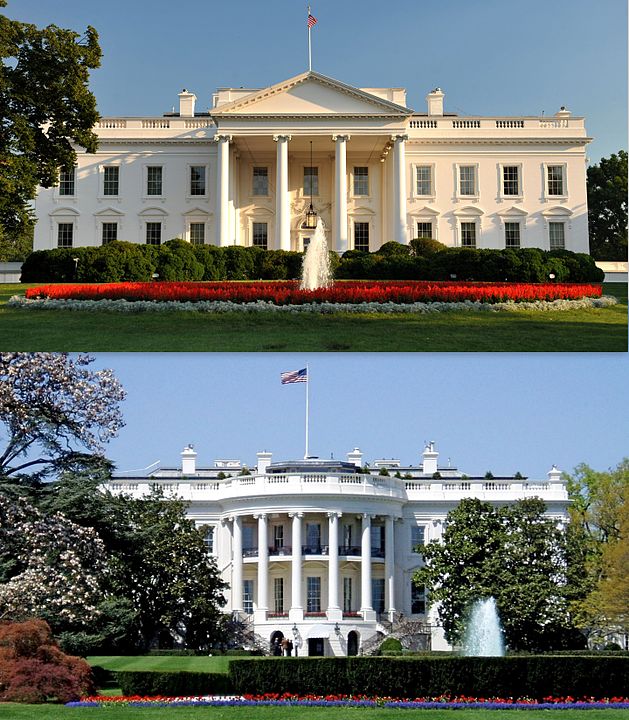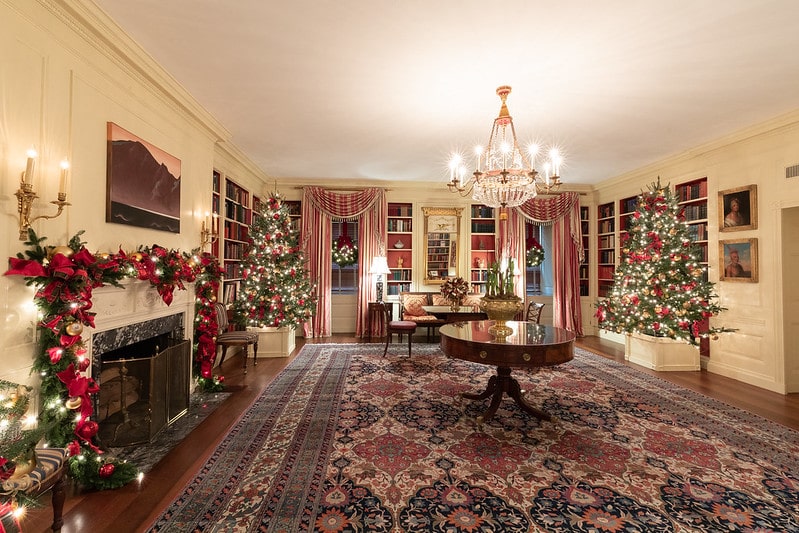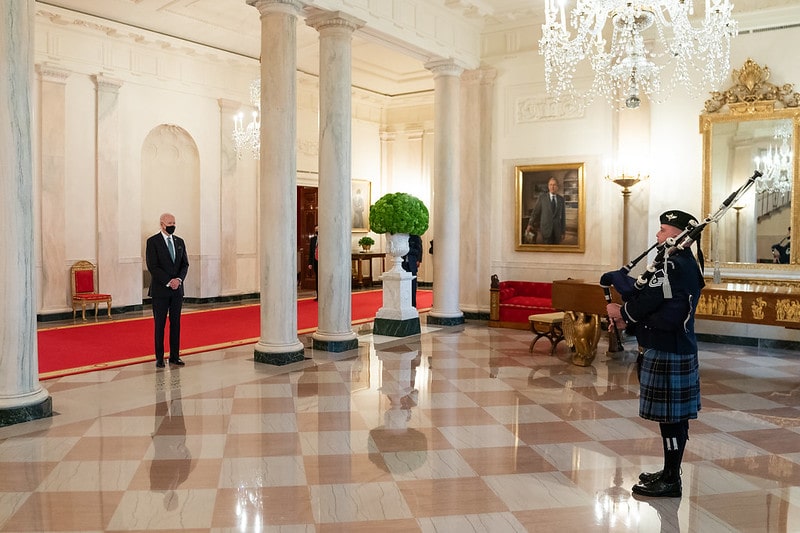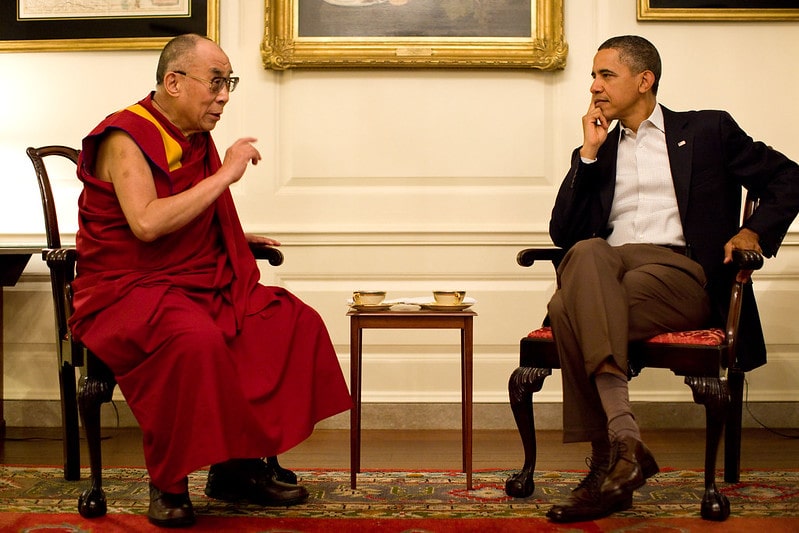Both home and workplace of the president of the United States, the White House stands stately and regal at 1600 Pennsylvania Avenue NW as an unmistakable emblem of American democracy. Every US president since John Adams and their families have made the building their home at one time or other and the history and the evolution of the building is closely intertwined with the history of the nation itself. Here took place numerous treaty signings, summit meetings and several other events of the kind that were to have huge impact on the global political scene. Referred by many as the “living museum of American history”, the history continues to unfold at this iconic building that is the While House.
50 Interesting Facts about the White House
Early History and Construction
1. The site of the historic building in the new capital city of Washington was chosen by George Washington (1789 — 97), the first US President, in 1791. He was assisted in the task by the renowned city planner, Pierre L’Enfant.
2. The cornerstone was laid on the October of next year and Washington was actively involved in the project during the next eight years of its construction.
3. By the time it was finished though (albeit partially), Washington was no longer in office and it was John Adams (1797-1801), the nation’s second president, who moved in the building on November 1, 1800.

4. Before the construction began, a public completion was staged requesting design submissions for the would-be presidential palace. Irish-born architect James Hoban’s drawing was chosen out of a total nine submissions.
5. Hoban’s design was of a Palladian style Georgian mansion spread across three floors and containing more than 100 rooms. Hoban won a $500 prize for having secured the commission.
6. Originally, it was planned that the sandstone for the building would be imported from Europe. Washington, however, insisted on native material and subsequently, sandstone from Aquia Creek quarries in Virginia was used for the building.
7. For all that, however, skilled stonemasons who were in charge of construction came from Edinburgh, Scotland.
8. Before the construction of the White House, there were two presidential palaces, one in New York and the other in Philadelphia. Both were occupied by Washington at different times during his eight-year tenure as the president.

9. By the time John Adams had moved in at the now iconic building, the entire federal government was already relocated from its previous seat in Philadelphia to the new capital city of Washington.
10. Adam’s stay at the house was to be short-lived, though, as the newly-elected President Thomas Jefferson (1801-09), the third US President, made his entry in the White House in March, 1801 amidst much fanfare.
11. Jefferson’s zealous republicanism meant that he made the house open for public visitation at a certain hour each morning. In different forms, the tradition has continued to this day.
12. Meanwhile, the construction work carried on inside the still unfinished building. Reportedly, Jefferson took an active interest in the work and drew up some plans himself, including landscaping plans for the garden.
13. It was also during Jefferson’s time that the building was elegantly and tastefully furnished in Louis XVI style. Henceforward, this particular style of furnishing will be referred to by people at large as the ‘Federal style.’
Burning Down, Reconstruction and Subsequent Expansions
14. During the war of 1812, British soldiers set fire to several federal buildings in the capital, including the White House (then Executive Mansion) and the Capitol, prompting the then President James Madison (1809 — 17) to flee the city.
15. James Hoban was again appointed for the reconstruction of the building which took no less than 5 years. The first president to move into the newly reconstructed building was President James Monroe (1817 — 25).

16. Monroe had the semicircular South Portico added to the building in 1824. Later in the decade, President Andrew Jackson (1829 — 37) added the North Portico.
17. Although a number of proposals were put forward especially in the late 19th century, the building did not undergo any significant alterations until President Theodore Roosevelt assumed office in September of 1901 and moved into the White House. Roosevelt had the West Wing (then known as the Executive Office Building) constructed in 1902 and relocated the presidential offices from the second floor (which was subsequently added to the family living quarters) to the West Wing.
18. President William Howard Taft (1909 — 13), Roosevelt’s immediate successor, oversaw the construction of the Oval Office within an enlarged West Wing. The East Wing will be added during the tenure of President Franklin Delano Roosevelt (1933 — 45).

19. However, by the time President Harry S Truman (1945 — 53) moved into the famous house, the building was already showing serious signs of structural weakness. Accordingly, in 1948, a major renovation plan was adopted with architect Lorenzo Winslow at the helm. All but the outer walls of the building were dismantled and reconstruction took more than 4 years to complete.
20. Central air conditioning was first installed in the White House during the above renovation.
21. The White House received its last significant alterations thanks to Jacqueline Kennedy, wife of President John F Kennedy (1961 — 63). Renowned for her refined taste as also for her beauty, Jacqueline was instrumental in turning the mansion into a center of national culture. She collected enough items of artistic and historic value and then tastefully designed the many rooms of the building with these items.
22. In 1962, Jacqueline also conceived of and then conducted a televised tour of the many rooms of the mansion to arouse public interest in the beauties of the place.
Interesting and Fun Facts
23. The very next night after he moved in to the then President’s Palace, apparently a still overawed John Adams wrote in a letter to his wife Abigail the following famous words:
I Pray Heaven Bestow the Best of Blessings on This House and All that shall hereafter inhabit it. May none but Honest and Wise Men ever rule under this Roof.
Much later, the quotation was inscribed, at the insistence of Franklin Delano Roosevelt, on the State Dining Room’s fireplace. The words however found their pride of place right beneath the portrait of Abraham Lincoln.
24. Evidently Abigail Adams didn’t share her husband’s enthusiasm once she arrived at the house. Quite appalled by the unfinished state of affairs, the first lady was particularly inconvenienced by lack of fence, yard and other basic outdoor facilities.

25. Reportedly, Abigail was in the habit of using the then still incomplete East Room for hanging out the laundry! She believed it would be altogether inappropriate to hang the president’s laundry outdoors.
26. Under the pseudonymous initials A.Z., Thomas Jefferson submitted a drawing plan for the building during the initial open public competition!
27. After he moved in at the house, however, Jefferson had two earthen mounds built on the south lawn of the house, apparently since he didn’t feel too comfortable staying that far away from his beloved Virginia Piedmont!
28. In 1827, a 20,000 strong frenetic crowd followed the “people’s president” Andrew Jackson into the house to celebrate his inauguration. Soon after though, pandemonium broke out: expensive glass and china were shatterred to the tune of several thousand dollars; Johnson had to flee to a hotel to save his skin; and the president’s aides had to fill large washtubs with punch and place them on the lawn to get the crowd out of the house!
29. There was no one at the door to receive Charles Dickens when he visited the White House on an official invitation during his 1942 tour to the US. Subsequently, the famed novelist let himself in and began exploring the building on his own.
30. Later, he came to a room full of people and found to his horror that many of them were actually spitting on the carpet freely and frequently enough! At a later date, the novelist remarked, half-ironically, that it was his firm belief that all presidential housemaids are paid high wages!

31. Following the assassination of Abraham Lincoln, many of the House’s belongings were looted while Mary Todd Lincoln lay grieving in her room for five weeks. Afterwards, she was accused of stealing government property whereupon an enraged Mary Lincoln prepared a detailed inventory of all the items she had taken with her while leaving the presidential house.
32. Many believe that Theodore Roosevelt’s decision to relocate the presidential offices from the mansion’s second-floor rooms to the newly constructed West Wing was prompted primarily with a view to accommodate his large family that included, in addition to his six children, a bear, a badger, several raccoons and snakes—all of the latter beloved pets of his progenies!
33. A refrigerator was among the first modern amenities to make their way to the interior of the grand mansion. It was installed in the living quarters in 1845. Soon after, in 1849, gas lighting was installed and later, in 1891, came electric lighting.
34. A Russian nobleman visiting the White House shortly before the Civil War was left thoroughly unimpressed by its magnitude. He commented that the mansion looked just about ‘sufficient for a private family’ and was far from what any European would expect of a president’s home.
35. In stark contrast, Jefferson, already during the early days in the house’s history, felt it to be too large—large enough, in Jefferson’s estimate, to accommodate one Pope, two emperors, and the grand lama! Later, President Benjamin Harrison’s wife Caroline Harrison would rue the fact that there was ‘no feeling of privacy’ on the property.
. . . continue reading on the next page
